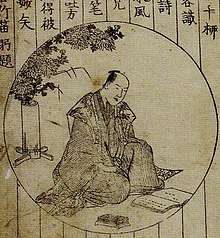Namiki Sōsuke
Namiki Sōsuke (Japanese: 並木宗輔; 1695 – c. 1751), also known as Namiki Senryū, was a prominent Japanese playwright who wrote for both kabuki and bunraku (puppet theater). He produced around 47 bunraku plays,[1] nearly 40 of them composed for jōruri, a particular form of musical narrative, and 10 kabuki plays.[2] He is considered the second greatest Japanese playwright after Chikamatsu Monzaemon.[3]
Namiki Sōsuke 並木宗輔 | |
|---|---|
 Portrait of Namiki Sōsuke | |
| Born | 1695 Osaka, Japan |
| Died | c. 1751 Japan |
| Occupation | Kabuki and bunraku playwright |
| Nationality | Japanese |
| Period | Edo |
| Genre | jidaimono |
Sōsuke was born in Osaka in 1695[4] and for the early part of his life he was a buddhist monk in the Jōjūji temple in Mihara, Bingo province.[5] He then left priesthood and settled in Osaka to become a playwright, starting as a disciple of Nishizawa Icchū in the Toyotake-za theatre.[6]
Collaborating with a number of other playwrights, including Takeda Izumo I and Miyoshi Shōraku, Namiki Sōsuke created some of the most famous traditional Japanese plays. Among them are Natsu Matsuri Naniwa Kagami (1745, Summer Festival: Mirror of Osaka), Sugawara denju tenarai kagami (1746, The Secrets of Sugawara's Calligraphy), Yoshitsune no senbonzakura (1747, The Thousand Cherry Blossoms of Yoshitsune), and Kanadehon chūshingura (1748, The Treasure of the Loyal Retainers). Namiki died while writing Ichinotani futaba gunki (1751, The Chronicle of the Battle of Ichi-no-Tani), but it was completed by some of his collaborators.[7]
One of his plays has been translated into English,[8] Summer Festival: Mirror of Osaka (1745, translated by Julie A. Iezzi) in Kabuki Plays on Stage I: Brilliance and Bravado, 1697–1770, edited by James R. Brandon and Samuel L. Leiter.
Plays
(The following list[9] is only a selection of Namiki Sōsuke's most famous works.)
- Izutsuya Genroku Koi no Kanzarashi (1723) with others, bunraku
- Hōjō Jiraiki (1726) with Nishizawa Icchū, bunraku
- Karukaya Dōshin Tsukushi no Iezuto (1735) with Namiki Jōsuke, bunraku
- Wada Gassen Onna Maizuru (1736) bunraku
- Kama-ga-Fuchi Futatsu Domoe (1737) bunraku
- Hibariyama Himesute Matsu (1740) bunraku
- Futatsu Biki Nishiki no Manmaku (1743) with Namiki Eisuke I, kabuki
- Natsu Matsuri Naniwa Kagami (Summer Festival: Mirror of Osaka,[10] 1745) with Miyoshi Shōraku and Takeda Koizumo I, bunraku. Adapted to kabuki the same year
- Sugawara Denju Tenarai Kagami (1746) with Takeda Izumo I, Miyoshi Shōraku and Takeda Koizumo I, bunraku. Adapted to kabuki the same year
- Yoshitsune Senbon Zakura (1747) with Takeda Izumo II and Miyoshi Shōraku, bunraku. Adapted to kabuki the next year
- Kanadehon Chūshingura (1748) with Takeda Izumo II and Miyoshi Shōraku, bunraku. Adapted to kabuki the same year
- Futatsu Chōchō Kuruwa Nikki (1749) with Takeda Izumo II and Miyoshi Shōraku, bunraku
- Genpei Nunobiki no Taki (1749) with Miyoshi Shōraku, bunraku
- Ichi-no-Tani Futaba Gunki (1751) with Asada Icchō, Namioka Geiji, Namiki Shōzō I, Naniwa Sanzō and Toyotake Jinroku, bunraku
Notes
- "Namiki Sōsuke". Oxford Index. Retrieved 2017-09-25.
- "Namiki Sōsuke". Oxford Index. Retrieved 2017-09-25.
- "NAMIKI SÔSUKE". kabuki21. Retrieved 2017-09-25.
- "Namiki Sōsuke". Oxford Index. Retrieved 2017-09-25.
- "Namiki Sōsuke". Global Performing Arts Database. Retrieved 2017-09-25.
- "NAMIKI SÔSUKE". kabuki21. Retrieved 2017-09-25.
- "NAMIKI SÔSUKE". kabuki21. Retrieved 2017-09-25.
- Kabuki Plays on Stage I: Brilliance and Bravado, 1697–1770. (2002) p. vii.
- "NAMIKI SÔSUKE". kabuki21. Retrieved 2017-09-25.
- Kabuki Plays on Stage I: Brilliance and Bravado, 1697–1770. (2002) p. vii.
References
- Takaya, Ted T. (1985). "Namiki Sōsuke." Kodansha Encyclopedia of Japan. Tokyo: Kodansha Ltd.
- Kabuki Plays on Stage I: Brilliance and Bravado, 1697–1770. (2002) University of Hawaii Press, ISBN 978-0-8248-2403-7.